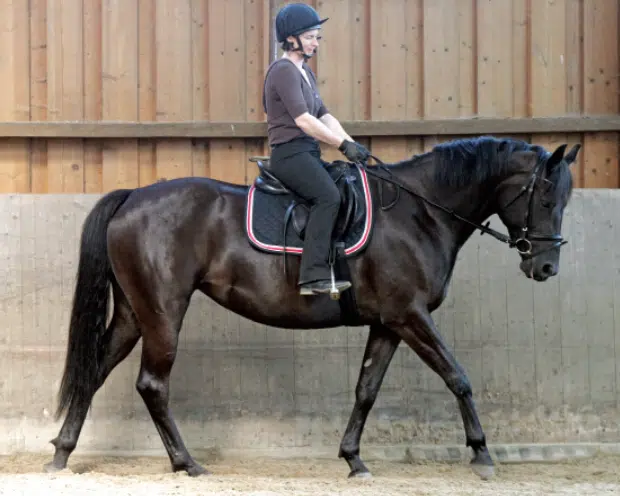[ad_1]
A study from Germany underscores the potential dangers that bacteria-laden arena dust pose to horses and riders alike.
Many factors can cause recurrent airway obstruction and inflammatory airway diseases in horses. But “exposure to inhaled dust and attached bacteria and fungi is a major contributor to respiratory problems,” says Nina Volkmann of the Institute for Animal Hygiene, Animal Welfare and Farm Animal Behavior of the University of Veterinary Medicine Hannover.
To determine the levels of bacteria in arena dust, the researchers collected air samples from four indoor riding arenas monthly over a one-year period.
On each occasion, the researchers took a preliminary sample before a riding session began—when the footing had been undisturbed for 10 hours—and a second one immediately after riding concluded. Researchers collected samples at four points along both the short and long sides of the arena and at two different heights, one approximately at the level of a horse’s nostrils and another at the height of the rider’s head.
Analysis of air samples
In all, the researchers analyzed 1,335 collected samples. They found that the bacterial loads in the airborne particles in all the arenas increased significantly after riding. Researchers determined that 80 percent of the airborne bacteria was Staphylococcus xylosus.

“The exact impact of the predominant species identified in this study (Staphylococcus spp.) on the health of riders and horses remains unknown. But Staphylococci [can be] involved in respiratory diseases,” says Volkmann. “Moreover, these bacteria originate from warm-blooded species, which means they are important indicators of contamination. It can be assumed that other bacteria such as Enterococci or Streptococci are also present in the air of riding arenas.”
Even if a horse doesn’t have any respiratory conditions, the inhalation of dust and the bacteria it carries can be harmful, says Volkmann. “Previous studies verified that higher dust environments are associated with an increased degree of airway inflammation.”
The researchers found no significant difference between the bacterial loads at the horse’s nostril level and the rider’s level, says Volkmann. “We would have expected to find higher bacterial burden at the height of the horses’ breathing zone. However, the air circulation in the arenas is an important factor, linking the arena to other adjacent places where dust is present, such as the barn area with straw and hay.”
Not only riders are at risk
That means that not only are riders at risk, but people on the ground in the arena are, too. “Depending on the condition of the arena, even instructors can experience health impairment. Breathing is deeper and the potential exposure to air pollution is worse when performing or riding. But often instructors stay longer in arenas than single riders.”
There are ways to reduce the amount of dust and bacteria in riding areas, says Volkmann. “Picking up manure from arenas will reduce the risk of inhaling harmful microorganisms,” she say, adding that maintenance and watering can help prevent dust development.
Reference: “Bacterial burden in the air of indoor riding arenas,” Agriculture, December 2022
[ad_2]
Source link
